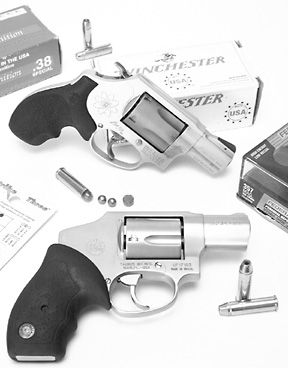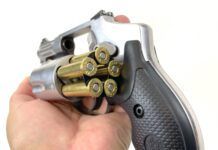
For carry purposes, a short-barreled (snub-nosed) revolver has many welcome attributes, including ease of concealment, maneuverability, ease of presentation, and comfort. The short barrel makes the gun easy to hide and handle, and having smooth surfaces can help minimize incidental contact during carry that can irritate or scrape one’s skin.
We recently tested two more guns in the huge snubby niche, the .38 Special +P Taurus CIA, which has an enclosed hammer like the Centennials, and .357 Magnum Smith & Wesson’s 360S, which is partially made of scandium, a metal said to be lighter and stronger than titanium.
As well as with regular cartridges, we tested the pair with Strike Three ammunition from Advance Tactical Firearms of Las Vegas, Nevada, (702) 362-7750. These rounds are multiple-projectile cartridges that disperse upon ignition. Whereas frangible ammunition disperses on impact, Strike Three sends three different slugs downrange separately with every shot. Hence our five-shot groups printed 15 different holes. The three projectiles consist of two spheres and a disc that we weighed out to be a total of approximately 116 grains. Effective range is described by the manufacturer (Armscor of the Philippines) as being zero to fifteen yards.
Here’s what we found:
Taurus CIA No. 2-850129CIA, $422
The Taurus CIA revolver is as close a straight-out copy of the Smith & Wesson Centennial revolver as you can get. This was a fortunate choice, because by emulating the the Centennial series, Taurus picked up on one of Smith & Wesson’s best designs. The main difference in design between the two is that while Smith & Wesson limits the use of a coil mainspring to their smallest J-frame models, this system is used throughout the Taurus lineup.
The CIA is an all-steel revolver, so naturally it is heavier than the 360S or any of the alloy revolvers available today. At 27 ounces it could be considered a heavyweight among five-shooters, ranked by weight neatly between the Smith & Wesson 640 Centennial and the Ruger SP101. However, these other guns are chambered for .357 Magnum, and the CIA, despite being listed in numerous publications as a magnum revolver, is chambered for .38 Special only.
Its finish is matte stainless throughout, and its two-inch barrel is shadowed by a full underlug that is cut away to completely enshroud the ejector rod. Lockup is aided by a spring-loaded detent on the crane, a feature becoming standard on all Taurus revolvers. We couldn’t help but notice that the spring rate on this detent pin is much heavier than on the other Taurus models we’ve tested.
The rubber grip completely encloses the frame and does a very good job of aiding the shooter’s hold and insulating it from blast. The supplied sights, which consist of a channel cut into the top strap and a serrated ramp, gave us a usable sight picture despite not being presented in contrasting colors. A key lock at the top of the backstrap locks the firing mechanism.
We found this model to be one of the best Taurus revolvers to date. The trigger is typical Centennial in feel and response. That is, its long stroke can be pulled straight through or staged. In this case, staging creates a moment of pause where the shooter can enact a separate press similar to single action. Our accuracy data was collected using a slow but consistent press without staging. While both the 360S AirLite SC and the Taurus CIA liked the Black Hills 125-grain +P ammunition best, the CIA proved more accurate, shooting the smallest group overall at 1.5 inches for an average of 1.9 inches measured center to center. The CIA was also way ahead firing Winchester’s 150-grain lead round nosed bullet, a respectable 3.0 inches at 15 yards. Velocity from this all-steel gun was substantially higher as well. With limited barrel length, the extra 75, 94, and 160 fps that the CIA produced from the Winchester, Black Hills and Strike Three cartridges respectively should come in handy.
[PDFCAP(2)].Of course, the CIA will not fire the .357 Magnum, but going to this cartridge for a small gun is never a pleasant experience for the shooter. In firing the multiple-projectile Strike Three cartridges, the collective group size was almost half that of those fired from the Smith & Wesson. But, is a smaller group preferable in this case? To say yes would mean that we prefer that the energy be carried further and delivered in a more concentrated manner. Certainly, this would read that the effective range of the Strike Three ammunition fired from the Taurus CIA is measurably further than in the case of shooting the Smith & Wesson 360S. The CIA proved to be 100 percent reliable with all ammunition without a hint of failure to ignite.
S&W 360S AirLite SC No. 163065 .357 Mag., $745
Can Smith & Wesson build a very light, small revolver? It would seem that Smith & Wesson’s answer to this simple question is, “It depends what you mean by ‘light.'” If a 16-ounce 442 or Bodyguard was not light enough, then how about an 11.2-ounce Chief’s Special? The 360S, chambered for .357 Magnum, weighs in at 16 ounces. This is a full 9 ounces less than the steel Centennial 640 and 4 ounces less than the alloy Bodyguard 649, Smith & Wesson’s other lightweight “pocket” magnums.
Heretofore, Smith & Wesson and Taurus have been adding titanium parts to reduce weight. In fact the cylinder of the 360S is also fashioned from Titanium. But, to increase strength, the aluminum used for the frame has been mixed with scandium, a rare and expensive component. What scandium does is increase the memory of the alloy that is produced. This is another way of adding strength rather than simply increasing hardness. The 360S also features a stainless steel barrel. Another part that continues the theme of elasticity is a steel insert located in the top strap just above the forcing cone. This piece actually floats in its own channel and shields the frame not only with its tensile strength but also with a small amount of spring action that allows it to be shoved it into its channel under pressure. When the 360S arrived, we noticed the insert was not flush with the frame. After firing this part fit tightly in place. When the gun cooled down we saw that it once again relaxed and curled away from the top strap.
Other features include a key-operated hammer lock located just above the cylinder release and a front sight that is serrated, colored a contrasting charcoal gray and pinned in place. The rear strap is relieved at the butt, offering connection for a lanyard. The Hogue Bantam grip ([800] GET-GRIP) offers a wide palm swell that is beneficial to fighting uncomfortable recoil. The widest part of the grip connects with the palm to allow the gun to rotate upward slightly under magnum pressure.
This is a feature of the Bantam Grip’s design that had gone unnoticed until we fired the heavier recoiling ammunition in this ultra-light gun. The overall shock from magnum rounds is substantial, but some of the stress applied to the wrist is alleviated by this design, much like rounded Bisley-styled grips allow the gun to rotate in the hand and expend muzzle flip.
The ejector rod is fully shrouded. There is no crane lock, but unlike the Taurus CIA, the tip of the ejector rod plays a part in lockup. However, we found the length of the ejector rod to be too short for sure removal of the longer magnum cases. We also noticed a small relief in the gas ring ahead of the cylinder and wondered if it was dented by use or was relieved by machining in production. While we are nitpicking, we have to mention that some of the graphics leave a little to be desired, and we wonder if the gun’s appearance can be blamed on the use of scandium. The 360S actually feels much lighter than it is, and it gave us much pause to fire full-power .357 Magnum ammunition. No, we didn’t think we could break the gun but we feared for our hand’s structural integrity. Even the “target” ammunition used for break in purposes was uncomfortable to shoot after a few rounds.
The magnum rounds were tested single-action only and did not provide us with exceptionally good groups. We had already seen that this model was picky in terms of accuracy, preferring, just as the Taurus did, the 125-grain +P rounds.
We are sure better .357 magnum results can be had than 4- and 5-inch groups, but the central issue—durability—does not seem to be a problem. Also, our experience firing the Strike Three ammunition in the 360S caused concern not about the gun but rather the ammunition. While it didn’t happen when we fired this cartridge from the Taurus revolver, we did notice unburned powder in and about the chambers of the Smith & Wesson after just a few rounds. We cleared the chambers, but we must have missed some of the debris, because inserting the next round of Strike Three became difficult. We removed it to find that our struggling with the cartridge had caused the plastic cap to crack. While frangible ammunition such as MagSafe is sealed with epoxy, Strike Three cartridges are simply capped with brittle plastic. This is a common practice, but one must be careful when using such rounds not to leave that plastic where it can clog the mechanism. The trouble point for the revolver would be between the cylinder and the forcing cone. For this reason we are not recommending the Strike Three ammunition.
The most often heard complaint about the 360S was the lack of comfort at the trigger face. While the trigger was smooth and radiused, a wider face would likely avoid the blistering and abrasion our shooters suffered. To minimize snagging of clothing, the hammer spur is somewhat abbreviated and angled almost parallel with the boreline. When held, the spur can be sheltered between the top strap and the web of the hand. For those preferring a shrouded hammer or hammerless design, we suggest the aforementioned 649 magnum or you might buy the 340SC, a Centennial version of this model.
Gun Tests Recommends
Taurus CIA .38 Special, $422. Best Buy. This is a very good bargain copy of one of Smith & Wesson’s best small-frame designs. It is accurate, cheap and comfortable to practice with. This makes it a good gun for first-time buyers intent on carry.
Smith & Wesson 360S .357 Magnum, $745. Conditional Buy. For the experienced shooter who does not need extra practice but who prefers a very concealable gun capable of safely firing higher-powered rounds, this gun may be ideal. Otherwise, the average buyer needs to balance the minimal weight and versatility of the 360S against its high cost and limited capacity.




























